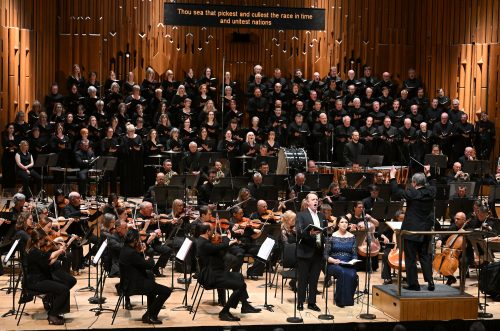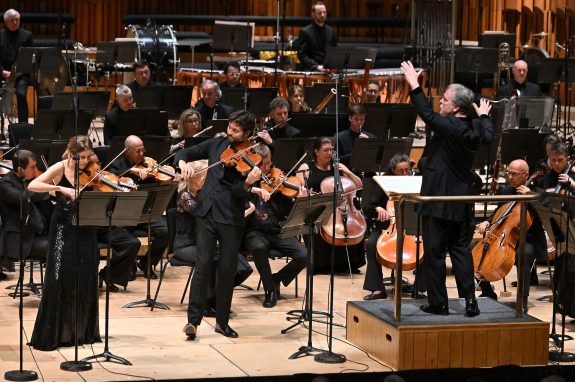 United Kingdom Knussen, Britten, Vaughan Williams: Silja Aalto (soprano), Morgan Pearse (baritone), Vilde Frang (violin), Lawrence Power (viola), BBC Symphony Chorus and Orchestra / Sakari Oramo (conductor). Barbican Hall, London, 24.5.2024. (AK)
United Kingdom Knussen, Britten, Vaughan Williams: Silja Aalto (soprano), Morgan Pearse (baritone), Vilde Frang (violin), Lawrence Power (viola), BBC Symphony Chorus and Orchestra / Sakari Oramo (conductor). Barbican Hall, London, 24.5.2024. (AK)

Knussen – Cleveland Pictures (London premiere, 2003-09)
Britten (orch. Colin Matthews) – Double Concerto in B Minor for Violin, Viola and Orchestra (1932)
Vaughan Williams – A Sea Symphony (1903-09, rev.1923)
This all-English programme performed with utmost professionalism by all participants gave us a competent partial survey of twentieth-century trials and tribulations of compositional processes. Admittedly, Knussen’s work represents the beginning of the twenty-first century, but it was commissioned in 1999 and the exactly one century which here separates Vaughan Williams and Knussen embraces the twentieth century.
Knussen’s piece remained unfinished although his untimely death nine years later in 2018 was not the cause. It is likely that Knussen has not completed because he was unsatisfied with this composition. The question arises: do we have the right to promote the piece?
The piece has been advertised for this concert (and specified in the programme notes) as a London premiere. This is the fact, but the programme notes make no mention of the history leading to this performance.
Cleveland Pictures were commissioned by the Cleveland Orchestra in 1999; all seven movements were meant to depict works from the collection of the Cleveland Museum of Art.
In the event, four movements were completed, two progressed to fully orchestrated fragments and one movement was abandoned as undeveloped sketches of about ten bars.
As revealed by Colin Matthews in the published score (2022), ‘the bulk of the work was composed in 2003 and scheduled for performance in 2004. But it was not finished in time, and further attempts at programming it in 2005 and 2009 fell through. Meanwhile Michael Tilson Thomas gave Olly the opportunity to read through the incomplete work with the New World Symphony in Miami in 2008. In spite of this successful reading, he remained dissatisfied with the music, and couldn’t be persuaded to revisit it or to explain what he felt was wrong with it.’
Faber Music published the score in May 2022, it was premiered on 24 June 2022 at the Aldeburgh Festival, that is performed twice by the BBC Symphony Orchestra on a special day devoted to Knussen’s music. (The Cleveland Orchestra performed it in December 2023.)
As seen in the score (and quoted by Knussen), the composition is ‘Dedicated to Tom and Jane Morris, written in grateful homage to colleagues whose initials head each movement’.
These are the dedicatees: 1. G.B; 2. A.G; 3. A.R.T; 4.C.M; 5. M-A.T; 6. nothing; 7. M.L.
Colin Matthews tells us that he is the proud dedicatee of No.4 but who are the others? I would so much like No.1 to be for British composer Geoffrey Bush but I will never know.
At almost 16 minutes long, the movements depict the composer’s response to seven great paintings (all in the collection of the Cleveland Museum of Art): Portail avec Penseur (Façades and Lake with Rodin) / Calabazas (Velasquez) / Dans les vagues (Gaugin) [Fragment] / Two Clocks (Tiffany and Fabergé) / St Ambrose (Goya) / Don Quixote (André Masson) [unplayable, only ten bars of sketches; not performed] / The Burning of the House of Lords and Commons (Turner) [Fragment]
The orchestral forces needed are extra-large – the title in the printed score is Cleveland Pictures for large orchestra – including about thirty percussion instruments divided between five players: also four flutes, four clarinets, three bassoons, brass instruments, two harps, celeste, piano and full strings.
Coming to Knussen’s piece for the first time was not easy. The soundscapes were fascinating and constantly varied but it was hard to be sure what was being depicted at which point. In spite of my intense listening, I got lost: I noted five movement instead of the six played. Looking at the score post-concert, I noted with relief that the second movement follows the first segue.
I wonder if future performances could display pictures of the relevant paintings?
Britten was still only 18, and a student at the Royal College of Music, when he composed his three-movement Double Concerto for violin and viola. His composition teacher John Ireland liked the piece, but Britten did not and left the piece without scoring orchestral parts. The question arises again (as above in connection with Knussen’s Cleveland Pictures): do we have the right to promote the piece?
We do not know what Britten thought of his Double Concerto later in life, if at all, but he did not do anything about it. However, Colin Matthews orchestrated it some twenty years after Britten’s death, providing viola players with a concerto worth playing. Not only did I like this concerto – which I heard for the first time at this concert – but my guest for the evening, an occasional concertgoer with no musical background – really enjoyed it: she much preferred it to the two other compositions on the programme.

After the initial orchestral fanfare, the concerto starts with the viola, followed by response from the solo violin. Such dialogues between the two solo instruments, with virtuoso runs and complicated rhythmic passages as well as beautiful cantilena sections, must be as challenging as satisfying for performers. Violinist Vilde Frang and viola player Lawrence Power delivered superbly. Power seemed to be in the driving seat, partly because of the musical material but probably also because he seemed to be thoroughly familiar with the orchestration: he could have conducted the piece with his unusually large and top-quality viola. According to the programme notes Power has two excellent violas but we do not know which he played on this occasion. I do not know what Britten experts think about Britten abandoning this piece but I cannot help thinking of Bartók’s First Violin Concerto – written in the years 1907–1908, but only published in 1956, 11 years after the composer’s death – composed during the period of his passionate love for the violinist Stefi Geyer who did not have similar feelings and did not even like the piece dedicated for her. Perhaps Britten, a competent viola player, composed the violin-viola double concerto for emotional reasons which he did not wish to revisit later.
Vaughan Williams’s A Sea Symphony (Symphony No.1) is also an early work although from the composer’s thirties, not from teenage student days, and he revisited and revised it. This is a full-scale choral symphony, lasting over an hour, for soprano, baritone, mixed choir, and a large orchestra including three flutes, three oboes, four clarinets, three bassoons, for horns, three trumpets, three horns, three trombones, tuba, three timpani, percussions, drum, two harps, organ, and full strings. The text of the four-movement choral symphony consists of poems by Walt Whitman. It is meant to be about the sea, sailors, and life on the sea but most of the time I could not help thinking that I was listening to some grand religious process reaffirming faith. I did watch the surtitles with the full text, but I was still wondering about seas in another world. It is my fault entirely, I am sure, but I fully appreciated the amazing BBC Symphony Chorus giving their most satisfying utmost best. They are a large amateur choir, this time well over a hundred people onstage, but there was nothing ‘amateur’ about their performance …except their obvious love for and dedication to music. Baritone Morgan Pearse managed the Wagnerian length with competence, confidence, and pleasing musicality. In the lesser role, soprano Silja Aalto fitted perfectly. The orchestra performed with top professional standard; not an easy task in this piece and, also, in the opening Knussen piece.
Conductor Sakari Oramo is one of those few conductors who is in full control of the scores and, therefore, of his performances. I could name many celebrity conductors who should take note.
The concert was recorded for broadcast on 11th June and for 30 days afterwards on BBC Sounds.
Agnes Kory
